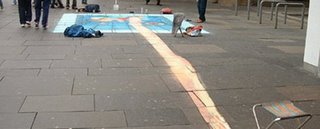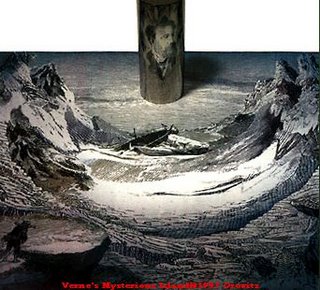Anamorphic Illusions
Tuesday, March 07, 2006
 Through an email from a coworker, I have learned of some fascinating illusions by an artist whose canvas is the sidewalk, and whose medium is chalk. Englishman Julian Beever is known for drawings that, when viewed from a certain angle, appear to be three-dimensional, a type of optical illusion known as anamorphosis. The page at the link quotes the definition from the 1913 edition of Webster's dictionary.
Through an email from a coworker, I have learned of some fascinating illusions by an artist whose canvas is the sidewalk, and whose medium is chalk. Englishman Julian Beever is known for drawings that, when viewed from a certain angle, appear to be three-dimensional, a type of optical illusion known as anamorphosis. The page at the link quotes the definition from the 1913 edition of Webster's dictionary.
A distorted or monstrous projection or representation of an image on a plane or curved surface, which, when viewed from a certain point, or as reflected from a curved mirror or through a polyhedron, appears regular and in proportion; a deformation of an image.In the case of Julian Beever, his chalk drawings on the sidewalk have a three-dimensional appearance when viewed from one angle, that of pedestrians approaching from one direction. For example, the topmost image at the right is one of Beever's drawings observed from the intended angle. The woman's leg appears to be sticking up out of the pool. (I believe you can see larger images by clicking on any of these.)

The effect is lost from anything but the intended direction. The second image at the right is the same drawing, now viewed from the opposite direction, where we learn what Webster means by "montrous projection". Many more excellent examples of Julian Beever's work can be found here. I have been told that pedestrians have been known to change their paths to avoid "bumping into" some of these.
This post would have originally ended by about this point since I intended it to be a break after a busy day on the job and with a longer post in the works besides, but things got really interesting as I checked into what, exactly, an "anamorphic illusion" was. Visit the first link in this post to see what I mean. For one thing, Some artists have created distorted images intended to be viewed with curved mirrors, like the stunning example at right, in which a reflective cylinder at the correct position reveals an image of Jules Verne.
Interestingly enough, anamorphosis is related to a technique, trompe l'oeil, an example of which fellow blogger Robert Tracy recently featured over at Illustrated Ideas.

Oblique anamorphosis is closely related to an artistic technique called trompe l'oeil (French for "deceiving the eye", pronounced "tromp loy"). Both use perspective constructions to create a "trick" image, but the difference lies in the nature of the trick. For an anamorphosis, the viewer is presented with something that does not make sense when viewed conventionally, and so he or she must seek out the unconventional viewpoint from which the trick is resolved. For trompe l'oeil, the viewer, standing in one particular (and usually conventional) place, is tricked into seeing an invented image as if it were reality. One of the most stunning examples of the technique is the fresco painting on the ceiling of the Church of Saint Ignazio in Rome, created by Andrea Pozzo during 1691-1694. A semi-circular roof is transformed into a fantastic picture of the heavens, in which Saint Ignatius ascends into paradise[.]So.... What are you waiting for? Follow the links!
-- CAV
Updates
3-8-06: Fixed spacing of images for what I hope is a neater appearance.

7 comments:
Fascinating stuff, Gus. Never would have encountered it. Nice!
Thanks, Vigilis!
I showed this to my wife, and all she said was, "Oh! That guy!" and didn't even go past the first paragraph! (Apparently, Beever has been featured in a documentary, which I haven't seen, before.)
I'm glad to see that sombody else appreciated this!
Gus
Julius Beever official page
http://users.skynet.be/J.Beever/index.html
Check it out its really kool
is there a tutorial on how to draw an anamorphosis?
Anon,
This tutorial looks promiing. HTH.
Gus
hello gus, :)
lately i've been doing all sort of research on anamorphosis. i'm an illustrator myself and since the day i saw julian beever's works, i told myself that i have to learn this technique. i clicked on the tutorial link u posted but it's a dead link.do u think u can help me on this? i can't sleep well anymore, just keep thinking, trying to figure out a smarter way to calculate the perspective :(
:) anyway, thanks, Gus!
Annie
Annie,
Thank you for pointing out the dead link. That's a shame.
I have the following alternate suggestions.
(1) See whether this helps.
(2) Look through this nice reference list.
(3) Try this archived web page of the original link. The problem with it is that the images are missing. However, there is an email at the end. Perhaps the author would be willing to supply you with the missing images. If he does, let me know.
Gus
Post a Comment